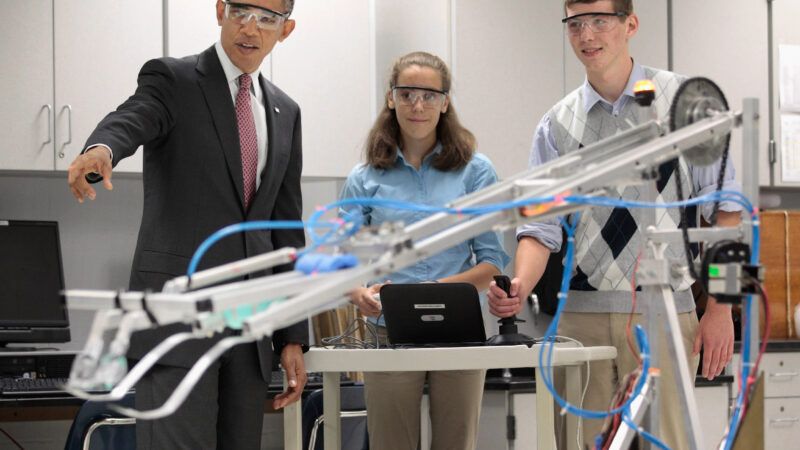Fairfax County School Board To Appeal Ruling Against Racial Balancing Efforts
The school board is fighting a federal judge’s ruling against a new admissions policy at Virginia's elite Thomas Jefferson High School.

The Fairfax County School Board has filed an appeal challenging a recent court ruling against controversial new admissions procedures at Thomas Jefferson High School for Science and Technology (TJ), a prestigious magnet school in Alexandria, Virginia.
The new admissions policy was intended to increase the proportion of black and Hispanic students at the school. It was struck down in late February by Judge Claude M. Hilton of the U.S. District Court for the Eastern District of Virginia, who ruled that the new policy "has had, and will have, a substantial disparate impact on Asian American applicants to TJ."
Before the challenged admissions policy was put in place, 73 percent of TJ students were Asian American. In 2021, the school was only 1 percent black and 3.3 percent Hispanic in a county in which 10 percent and 16 percent of the population is black and Hispanic, respectively. This led to the school being described by Didi Elsyad, who was one of the six black students in her grade at TJ, as "segregation in its modern form."
In 2020, following the death of George Floyd, the Fairfax County School Board made sweeping changes to the school's admissions policy for the 2021-2022 school year. Formerly, applicants were required to take three hours of standardized tests to proceed to the semifinalist round of admissions to TJ, which accepts students from across several districts in Northern Virginia. The new policy nixed the standardized testing in favor of requiring applicants to have taken or be enrolled in middle school honors classes that cover the same material as the standardized tests. The school board also added a "student experience sheet" that allowed TJ's admissions team to account for household income, learning disabilities, and whether the applicant is a native English speaker. The policy also placed a percentage cap on the number of students coming from each feeder middle school.
The changes had a staggering effect: According to the lawsuit, the class of 2024 was 73 percent Asian, while the class of 2025 is 54 percent Asian. Meanwhile, the share of black students increased from less than 1 percent in the 2024 class to 7 percent in the 2025 class, and the share of Hispanic students increased from 3.3 percent to 11 percent.
After the new admissions policy was announced, 17 Northern Virginia families, many of them parents of students who applied to or attend TJ, formed the Coalition for TJ and filed a lawsuit against the school board. They claimed that dispensing with race-blind standardized tests in favor of the new criteria amounted to illegal racial discrimination intended at placing an informal quota on Asian students.
In February, Judge Hilton agreed. He struck down the new admissions procedures as having "disproportionately deprived" Asian American applicants "of a level playing field" and ordered Fairfax County Schools to reverse course on their new admissions policy.
On Monday, the school board filed an appeal claiming that the decision does not take existing case law into account. The board also claims that "the intent of the school division was to design a process that removes systemic screening barriers that have historically impacted talented students from diverse backgrounds."
However, the school is likely to face an uphill battle in preserving its new policy. While it claims to be removing "systemic barriers," it seems to have done so by trying to reduce the Asian American student population. One Fairfax County School Board member reportedly texted another about the proposed changes: "I mean there has been an anti-Asian feel underlying some of this, hate to say it lol."
The solution to issues of educational opportunity and lack of diversity—essentially, problems caused by past racial discrimination—cannot be solved by adopting the "right" kind of racial discrimination now.
Harry Jackson, the black father of a TJ student and a member of the Coalition for TJ, wrote in The Washington Post: "I would also like to see more Black and Hispanic students at the school. But if those students are not making the grade, the problem isn't the standards. It's more likely that the elementary school pipeline is failing to prepare them for the rigors of an environment like TJ."
Increasing the share of black and Hispanic students at TJ should come from improving the quality of underperforming Fairfax County schools so that more black and Hispanic middle school students can pass the school's entrance exam.
"TJ freshmen are expected to be able to handle AP-level mathematics and computer science as soon as they enter the school," Aditya Kumar, a recent TJ alum, tells Reason. "I just don't think middle school performance can predict that but a tough standardized test can."
The new policy is not all bad, however. Removing the school's $100 application fee—a change that occurred alongside the new admissions standards—makes it significantly easier for lower-income students with high aptitudes to gain entrance into the school fair and square.
The issues raised by this recent controversy are not likely to go away any time soon. In January, the Supreme Court said it would hear cases challenging race-conscious admissions procedures at Harvard and the University of North Carolina.
Show Comments (25)